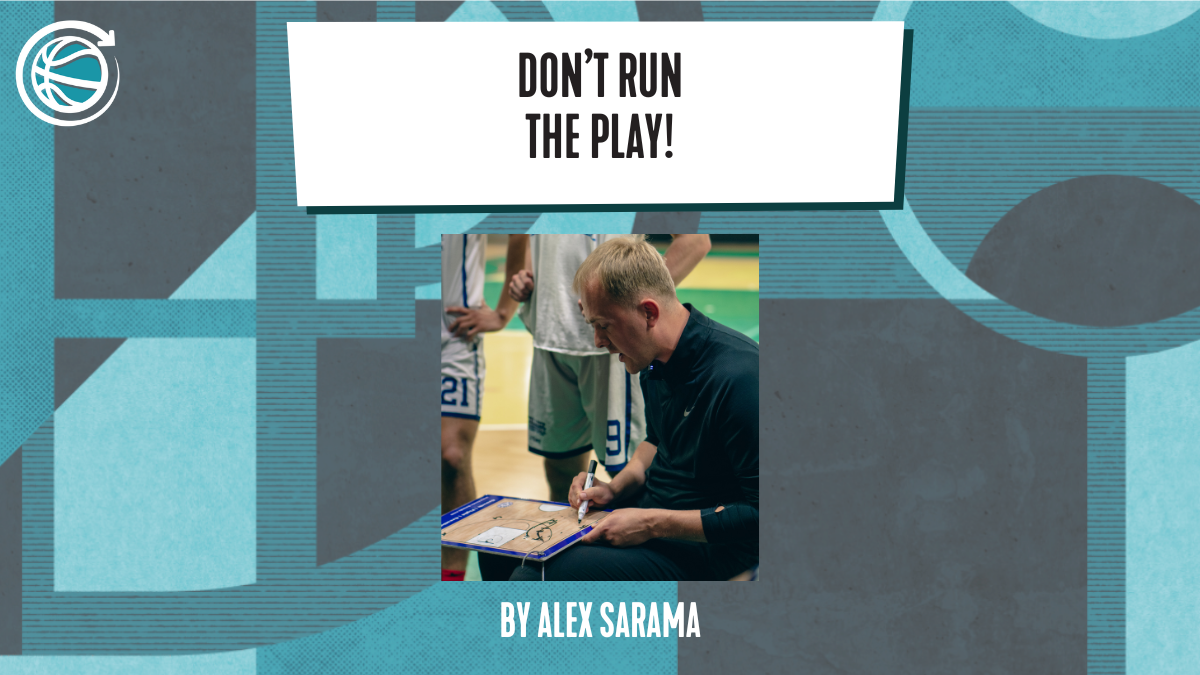Don’t Run the Play!
June 17, 2024
Many coaching styles develop overtly passive offensive players, who focus on merely regurgitating patterns versus acting upon natural affordances which create an offensive advantage. System-based coaching philosophies have led to generations of robotic players being produced, all because of outdated coaching attitudes focussed on the importance of “players running the system.”
One must ask what is the purpose of offense? Is it to merely run a pattern and move from point A to point B, or is it to create an advantage and disorientate the defense? The problem is that many coaching styles do not promote the latter because of how strictly coaches insist that their players run a motion offense or set play to “perfection” (whatever that means!).
Something I have emphasised to players throughout my career is to not run the play! Of course, there is a delicate balance with this. For instance, when running set plays, these provide useful opportunities to disorganise the defense. However, if we “shatter the ice” (Zico Coronel phrase on the Transforming Podcast) early on within the set and the defense is in a state of disorganisation, then the set is over and we merely play in dominoes. This requires a careful balancing act for players to perceive when to continue to the next part of the set and when to break it off.
Naturally, how will players be attuned to knowing when to do this if they practice the majority of their sets through 5-on-0 practice? There is a great example of “breaking the set” in the video clip below. My team was about to execute a very simple SOB in practice, when the inbounder Linus Holmstrom perceived the over-help from the weak side. Subsequently, the skip pass emerged and we obtained a high value shot within our shot spectrum (a catch and shoot corner 3PT).
https://twitter.com/AlexJSarama/status/1629075052376338433?s=20
The inability of players – especially at the highest levels – to consistently act on affordances that present themselves during an offensive possession is something that frequently stands out to me. Why is this such a reoccurring theme within the basketball world? A form of life accounts for the way and manner in which athletes may perform in a particular sport. Rothwell, Davids and Stone (2018) proposed how forms of life are founded upon “specific socio-cultural, economic and historical constraints that have shaped the development of performance in a particular sport and physical activity.”
I believe that the way in which coaches have approached offense has led to a form of life developing within basketball which has limited progress substantially! I believe this has contributed to players being far more robotic on offense than they otherwise would be without such restrictive coaching styles. The norms of how basketball should be played have led to many teams all over the world approaching offense as a form of pattern rehearsal. Whether coaches use set plays, motion continuity or triggers within a conceptual offense, teaching an offense through the lens of replicating patterns is extremely limiting.
When the intentions and attentions of the players are overtly focussed on getting into their own individual positions and running a patterned sequence, as opposed to attuning to key specifying information (e.g. movements of defenders and teammates), the offense risks being highly fragile. Viewing the game through patterns is simply far too reductionist for the complexity of what basketball entails.
Simply because basketball has been played this way for years, does it mean that this is the only way that offense has to be coached? The problem with this perspective is two-fold. Firstly, many coaches frequently chastise their players for acting on an advantageous affordance at the start of the offense in order to “run the play”. Secondly, a greater problem occurs from how coaches approach these offensive patterns. To instill them, practice is decomposed into 3-on-0 or 5-on-0 tasks where players tediously repeat the offensive patterns until the coaching staff believe the execution is good enough. This is the anthesis to develop skilled, adaptive basketball players.
The essence of using set plays is not the problem. Rather, it is the way in which they are framed, explained and coached to the players. Using sets does not mean that players will not develop attunement to the affordances that present themselves out of every part of the set. This means a set could be introduced through some form of 5-on-5 with live or guided defense. Various task constraints could be introduced to encourage the offense to explore the advantage-creating actions at various moments of the set.
Learn more about using principles of play in E30 of the Transforming Podcast:

Leave a Reply Cancel reply
Community Ideas
CATEGORY
browse by
Skill Acquisition
Practical Ideas
Principles of Play
News
The Theory
Author
browse by
Adam Omiecinski
Alex Sarama
Kareem Kalil
Jonas de Bruyne
CATEGORY
News
browse by
The Theory
Community Ideas
Skill Acquisition
Practical Ideas
Principles of Play
Adam Omiecinski
Alex Sarama
Kareem Kalil
Jonas de Bruyne
Author
browse by